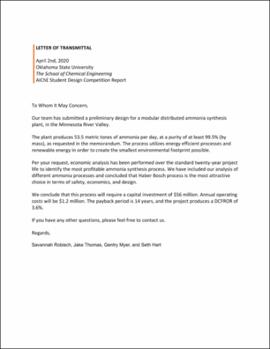| dc.description.abstract | In the United States ammonia is primarily produced along the Gulf Coast due to the availability of cheap, abundant natural gas. However, the majority of the ammonia is used for fertilizer and shipped to agricultural regions. Shipping is expensive and can lead to hazardous or dangerous incidents. An option to change the current ammonia supply chain includes designing a clean, modular ammonia plant capable of producing 50 mtpd in the Minnesota River Valley. Designing the plant required exploration and analysis of different processes in clean, modular ammonia synthesis. Various process design elements were considered, but ultimately the most inherently safe, clean, and economically attractive processes were chosen. The ammonia plant design consists of nitrogen generation via pressure swing adsorption, hydrogen generation via electrolysis of water, anhydrous ammonia synthesis via the Haber Bosch process, and the installation of a wind farm to decrease the overall electricity cost. The capital cost to construct a grassroots modular facility in the Minnesota River Valley is estimated to be $63.9 million. The ammonia production process consists of 12 compressors, 15 heat exchangers, 10 electrolyzers, 6 vessels, 2 adsorbers, 1 plug flow reactor, 1 water purifier, and 1 ammonia storage tank. All of the equipment was designed for a modular purpose. A total of 15 operators will be needed for an annual cost of $898 thousand. The utility costs are estimated to be around $1.23 million. The utility costs were mitigated with the addition of the wind farm to cover the electricity needs of the plant. Once becoming more aware of the location and current legislation, tax breaks and incentives for environmentally friendly process plants will be considered. Due to extra capital cost being invested into a more environmentally aware production facility, tax incentives will be advantageous to plant value. The project has an annual revenue of $14.6 million, a 20-year useful plant life, and minimum acceptable rate of return of 8%. The NPV of the project is $21.8 million with a DCFROR of 3.66% and payback period of 14 years. The process is economically attractive but not viable under current circumstances due to such large deviation within the sensitivity analysis. | |
